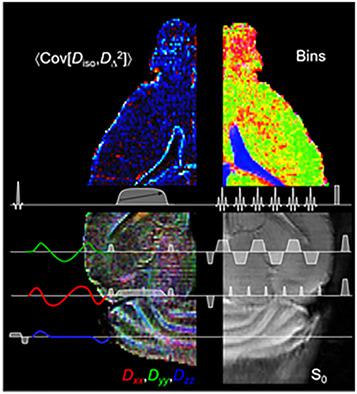当前位置:
X-MOL 学术
›
NMR Biomed.
›
论文详情
Our official English website, www.x-mol.net, welcomes your
feedback! (Note: you will need to create a separate account there.)
Diffusion tensor distribution imaging of an in vivo mouse brain at ultrahigh magnetic field by spatiotemporal encoding.
NMR in Biomedicine ( IF 2.7 ) Pub Date : 2020-08-19 , DOI: 10.1002/nbm.4355 Maxime Yon 1 , João P de Almeida Martins 2, 3 , Qingjia Bao 1 , Matthew D Budde 4 , Lucio Frydman 1 , Daniel Topgaard 2, 3
NMR in Biomedicine ( IF 2.7 ) Pub Date : 2020-08-19 , DOI: 10.1002/nbm.4355 Maxime Yon 1 , João P de Almeida Martins 2, 3 , Qingjia Bao 1 , Matthew D Budde 4 , Lucio Frydman 1 , Daniel Topgaard 2, 3
Affiliation

|
Diffusion tensor distribution (DTD) imaging builds on principles from diffusion, solid‐state and low‐field NMR spectroscopies, to quantify the contents of heterogeneous voxels as nonparametric distributions, with tensor “size”, “shape” and orientation having direct relations to corresponding microstructural properties of biological tissues. The approach requires the acquisition of multiple images as a function of the magnitude, shape and direction of the diffusion‐encoding gradients, leading to long acquisition times unless fast image read‐out techniques like EPI are employed. While in previous in vivo human brain studies performed at 3 T this proved a viable option, porting these measurements to very high magnetic fields and/or to heterogeneous organs induces B0‐ and B1‐inhomogeneity artifacts that challenge the limits of EPI. To overcome such challenges, we demonstrate here that high spatial resolution DTD of mouse brain can be carried out at 15.2 T with a surface‐cryoprobe, by relying on SPatiotemporal ENcoding (SPEN) imaging sequences. These new acquisition and data‐processing protocols are demonstrated with measurements on in vivo mouse brain, and validated with synthetic phantoms designed to mimic the diffusion properties of white matter, gray matter and cerebrospinal fluid. While still in need of full extensions to 3D mappings and of scanning additional animals to extract more general physiological conclusions, this work represents another step towards the model‐free, noninvasive in vivo characterization of tissue microstructure and heterogeneity in animal models, at ≈0.1 mm resolutions.
中文翻译:

通过时空编码在超高磁场下体内小鼠大脑的扩散张量分布成像。
扩散张量分布 (DTD) 成像建立在扩散、固态和低场核磁共振波谱学原理的基础上,将异质体素的含量量化为非参数分布,张量“大小”、“形状”和方向与对应的有直接关系。生物组织的微观结构特性。该方法需要采集多个图像作为扩散编码梯度的大小、形状和方向的函数,导致采集时间较长,除非采用 EPI 等快速图像读出技术。虽然之前在 3 T 下进行的体内人脑研究证明这是一种可行的选择,但将这些测量结果移植到非常高的磁场和/或异质器官会引起B 0和B 1不均匀伪影,从而挑战 EPI 的极限。为了克服这些挑战,我们在此证明,依靠时空编码 (SPEN) 成像序列,可以使用表面冷冻探针在 15.2 T 下对小鼠大脑进行高空间分辨率 DTD。这些新的采集和数据处理协议通过对小鼠体内大脑的测量得到证明,并通过旨在模拟白质、灰质和脑脊液扩散特性的合成模型进行了验证。虽然仍需要全面扩展 3D 映射并扫描更多动物以提取更一般的生理学结论,但这项工作代表了动物模型中组织微观结构和异质性的无模型、非侵入性体内表征又向前迈出了一步(约 0.1 毫米)决议。
更新日期:2020-10-05
中文翻译:

通过时空编码在超高磁场下体内小鼠大脑的扩散张量分布成像。
扩散张量分布 (DTD) 成像建立在扩散、固态和低场核磁共振波谱学原理的基础上,将异质体素的含量量化为非参数分布,张量“大小”、“形状”和方向与对应的有直接关系。生物组织的微观结构特性。该方法需要采集多个图像作为扩散编码梯度的大小、形状和方向的函数,导致采集时间较长,除非采用 EPI 等快速图像读出技术。虽然之前在 3 T 下进行的体内人脑研究证明这是一种可行的选择,但将这些测量结果移植到非常高的磁场和/或异质器官会引起B 0和B 1不均匀伪影,从而挑战 EPI 的极限。为了克服这些挑战,我们在此证明,依靠时空编码 (SPEN) 成像序列,可以使用表面冷冻探针在 15.2 T 下对小鼠大脑进行高空间分辨率 DTD。这些新的采集和数据处理协议通过对小鼠体内大脑的测量得到证明,并通过旨在模拟白质、灰质和脑脊液扩散特性的合成模型进行了验证。虽然仍需要全面扩展 3D 映射并扫描更多动物以提取更一般的生理学结论,但这项工作代表了动物模型中组织微观结构和异质性的无模型、非侵入性体内表征又向前迈出了一步(约 0.1 毫米)决议。











































 京公网安备 11010802027423号
京公网安备 11010802027423号